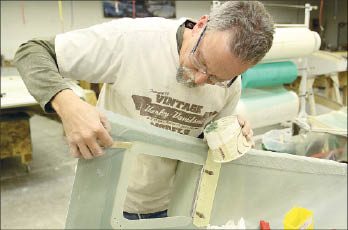
Home » Aerocet stays afloat during 'slow' season
Aerocet stays afloat during 'slow' season
Airplane pontoon maker credits sister company's growth, strong demand

December 15, 2011
Aerocet Inc., a North Idaho manufacturer of composite floats for aircraft, is enjoying the busiest "slow" season it's ever had. As of early this month, the company's workforce was 34 and expected to increase yet this winter, says Garry Hojan, Aerocet's operations manager.
Historically, the company has had to lay off employees in the fall. One winter, after the recession took hold in 2008, Aerocet was down to 15 employees from a peak of 50.
This year is different.
"We're having the best fall ever," Hojan says. "Now, we're hiring."
Based in the small town of Priest River, Aerocet claims it makes the only composite floats that are certified by the Federal Aviation Administration for use on several models of aircraft, including Quest Kodiak, de Havilland Beaver, and four Cessna Aircraft Co. models.
Floats are the pontoons that allow airplanes to land and float on water. FAA certification means the floats meet quality and performance standards the federal agency sets for use on civil aircraft.
Aerocet makes floats to order and expects to manufacture 60 to 70 sets of floats next year, with each set priced from $27,000 to $90,000.
Hojan says some of the improvement this fall can be attributed to the growth of its sister company, Sandpoint-based small-aircraft maker Quest Aircraft Co.
Aerospace designer Tom Hamilton founded Aerocet in 1986 in Arlington, Wash. Hamilton had earlier founded Stoddard-Hamilton Aircraft Inc., which manufactured the Glasair line of kit planes he designed. That company changed hands in 2001.
Aerocet initially had contracts with Boeing and NASA, and the company's main products were composite missile casings.
When the government contracts ran out, Ham-ilton envisioned other aerospace applications for the composite technology.
Hamilton moved from Arlington to a ranch north of Priest River in 1995, taking Aerocet with him and running the company out of a garage before settling it in two industrial buildings with a combined floor space of 35,000 square feet on the western edge of Priest River.
Prior to the move to Idaho, Hamilton had begun design work on an economical workhorse of a bush plane to replace smaller, aging planes used for missionary work in remote regions of South America, Africa, and Asia, Hojan says.
That effort eventually became Quest Aircraft, maker of the 10-seat Kodiak airplane. Quest originally was co-located with Aerocet in Priest River and moved to Sandpoint where it began production in 2001. Today, that company has more than 100 employees and orders for more than 120 aircraft, Hojan says.
Part of Aerocet's workforce is dedicated to making parts for Quest Aircraft.
Aerocet has several sets of floats in various stages of production at any given time, and it takes eight to 10 weeks to manufacture each set, Hojan says.
Nine dealerships sell and install Aerocet floats. Five are in the U.S., three are in Canada, and three are in other countries. The Aerocet dealer closest to the factory is in Renton, Wash.
The company also manufactures composite cargo pods that attach to the belly of certain models of aircraft, fairings that help reduce drag caused by air and water friction, and other related aircraft parts.
Even with Aerocet's history of cyclical production, most employees have been with the company for several years, Hojan says.
"We don't have employee turnover," he says.
Each year, he adds, the company learns more about how to handle seasonal fluctuations.
The post-recession rebound in product demand this year, though, has lasted well beyond the peak summer season, he says.
"We did a lot of overtime last year," he says. "This year, we're ramping up with more employees. These are good problems to have."
The composite material the floats are made of consists of two layers of glass-fiber cloth that sandwich a half-inch-thick foam board. The layers are bonded with epoxy resin in a process that makes the composite material stronger and more durable than aluminum, Hojan says.
Although some of Aerocet's manufacturing method is proprietary, such as applying the epoxy resin evenly and thoroughly through a vacuum process that makes the composite material conform to the mold, the company uses mostly conventional fiberglass materials.
"We don't use exotic materials," he says.
Aerocet's engineers design floats in Priest River, and a West Coast company turns the designs into full-sized convex molds, or plugs, of the design.
Aerocet then makes two-piece concave molds, around the plugs. The two-piece molds are used to make the top and bottom shell of the float.
Before bonding the pieces together, workers attach composite bulkheads to provide structural support and divide the hollow interior of the floats into partitions, which are accessible for storage.
More than half of the sets of floats Aerocet makes are amphibious, meaning they have retractable wheels for land-based takeoffs and landings, Hojan says.
Aerocet makes most of the plastic and metal parts that go into floats, including proprietary wheels for the landing gear.
Some metal parts take a year to make.
"For some parts, we have to soften the metal, bend it, harden it, and anodize it," Hojan says.
The company also designed the system that controls the retractable landing gear, including its electronic components.
The company maintains an ongoing research-and-development program and has plans to expand its product lines to include larger floats for Kodiak airplanes on one end of its spectrum and smaller floats for light-sport aircraft on the other end, Hojan says.
"It's a combination of high technology and good old-fashioned craftsmanship," he says. "We've been around 25 years and continue to grow and improve."
Latest News
Related Articles




